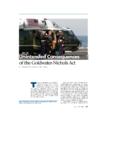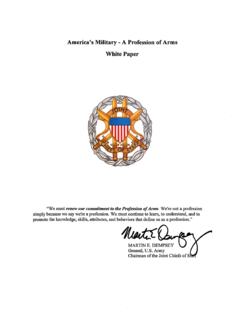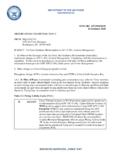Transcription of Goldwater-Nichols and the Evolution of Officer Joint ...
1 Goldwater-Nichols and the Evolution of Officer Joint Professional Military Education (JPME) Kristy N. Kamarck Analyst in Military Manpower January 13, 2016 Congressional Research Service 7-5700 R44340 Goldwater-Nichols and the Evolution of JPME Congressional Research Service Summary In November 2015, the Senate Armed Services Committee initiated a review of the Goldwater-Nichols Act (GNA). This piece of legislation, enacted in 1986 and amended in subsequent years, led to major reforms in defense organization. The year 2016 will mark the 30th anniversary of this landmark legislation and lawmakers have expressed interest in whether the changes, as implemented, are achieving the goals of the reform, and whether further reforms are needed to achieve current and future national security goals.
2 One of Congress main goals of the legislation was to improve Joint interoperability among the military services through a series of structural changes and incentives for participation in Joint matters. Joint matters, by statute (10 661) are currently defined as, ..matters related to the achievement of unified action by multiple military forces in operations conducted across domains such as land, sea, or air, in space, or in the information Modifications of the Officer management system under the GNA reforms were intended to enhance the quality, experience, and education of Joint officers. The law required, for the first time, that officers complete Joint Professional Military Education (JPME) in order to be eligible for certain Joint assignments and promotion categories.
3 Some have questioned the extent to which these statutory JPME requirements are achieving the goals of the reform and whether they should be amended or repealed. Others have questioned whether the JPME curriculum, method of delivery and instruction, course structure, and career timing are appropriate in the context of today s strategic environment and force structure needs. In parallel to congressional efforts, Secretary of Defense Ashton Carter announced in December 2015 that the Department of Defense (DOD) would be launching a review of the department s structure and efficiency in the context of the GNA reforms. A DOD memorandum dated January 4, 2016 outlined the key questions that would be addressed in this review. With respect to the Joint Officer management system, DOD plans to consider, 1.
4 Do current law and policy governing Joint duty qualifications provide the right human capital development to meet our Joint warfighting requirements? 2. Are there adjustments that can be made to balance the often competing demands of Joint professional development and other specialized expertise or other career development considerations? A spokesman for DOD indicated that this review might result in internal policy changes and/or legislative proposals. Any reforms to the military personnel management system might also be considered in conjunction with DOD s Force of the Future initiative, the first phase of which was launched by Secretary Carter on November 18, 2015. The purpose of this initiative is to improve the department s ability to recruit and retain the talent it needs to adapt to future mission requirements.
5 Goldwater-Nichols and the Evolution of JPME Congressional Research Service Contents Overview of this Report .. 1 Joint Military Education Pre-GNA .. 1 Goldwater-Nichols Act: A New Framework for Joint Officer Management .. 2 The Skelton Panel and Implementation of Goldwater-Nichols (1987-1990) .. 4 Evolution of JPME .. 4 Roles of Military Schools (1994) .. 5 Building a Strategic Approach to JPME and Joint Officer Management (2001 - 2005) .. 5 A New Joint Qualification System (2007) .. 7 Professional Military Education Two Decades after the Goldwater-Nichols Act (2010) .. 8 Changes to JPME in Recent Congresses .. 9 Acquisition as a Joint Matter .. 10 Other Issues for Congressional Consideration .. 10 Figures Figure A-1. Map of in-Residence Service and Joint Colleges and Universities Certified to Provide Joint Professional Military Education.
6 14 Tables Table 1. Goldwater-Nichols Act Goals and Initiatives for Officer Management .. 3 Table 2. Joint Qualification Criteria .. 8 Appendixes Appendix. Additional JPME Information .. 13 Appendix A. Acronyms .. 15 Contacts Author Contact Information .. 15 Goldwater-Nichols and the Evolution of JPME Congressional Research Service 1 Overview of this Report The Goldwater-Nichols Act of 1986 led to major changes in Officer training and career development through the establishment of a Joint management system. This system includes four basic components: Joint Professional Military Education (JPME) in Joint schools, a Joint Duty Assignment List (JDAL), Joint Specialty Officer (JSO) designation, and Joint criteria for promotions. This report focuses mainly on JPME requirements in the context of the intent of the Goldwater-Nichols reforms.
7 Although it refers to Joint Officer assignments and promotions, it does not address the Joint Officer management system as a whole. The first sections provide background on Joint education and the changes put in place by GNA. The following sections discuss the implementation and Evolution of JPME over the past 30 years. The final section lays out some of the stakeholders concerns and issues with the current state of JPME that Congress may consider as they conduct their GNA review. Joint Military Education Pre-GNA The education of military officers in Joint operations predates any legislation requiring both Joint education and experience. The Army Industrial College had been established in 19241 to educate officers in mobilization, supply, and industrial support, but no similar school was devoted to the study of Joint operations.
8 During World War II, following the military s exposure to working with allies in Joint operations, military leaders saw a critical need for officers to be trained and educated in Joint and combined operations. To fill this void, the Joint Chiefs of Staff established the Army-Navy Staff College in 1943 to provide a four month course for selected senior officers assigned to unified command and staff A memo by General Henry H. Hap Arnold, then-Commanding General of the Army Air Forces, described the purpose of this War College as: (1) To train selected officers of the Army and Navy for command and staff duties with unified (Army-Navy) commands. (2) To develop methods and ideas for the most effective unified employment of all arms and services and to translate lessons learned in the field into appropriate doctrines.
9 Conclusions reached should be spread through the services both by service publications and by the influence of the graduates of the College in planning and conducting The original Army-Navy Staff College evolved into the National War College in 1946 and the Army Industrial College was later renamed the Industrial College of the Armed Forces (ICAF). The Armed Forces Staff College (AFSC)4 was also formed in 1946 to provide Joint operational instruction to mid-grade officers (O-4 to O-6). By 1946, and primarily at the initiative of the senior military leadership, there were three military institutions devoted to various aspects of Joint education the National War College, the ICAF, and the AFSC. The services retained their 1 Established by War Department General Order No.
10 7, February 25, 1924, at Fort McNair, Washington It later became the Industrial College of the Armed Forces (ICAF) and is now the Dwight D. Eisenhower School for National Security and Resource Strategy. 2 Yaeger, John W., The Origins of Joint Professional Military Education , Joint Forces Quarterly, National Defense University Press, issue 37, April 2005. 3 Ibid., p. 76. 4 AFSC was incorporated into the National Defense University in August 1981 and was later renamed the Joint Forces Staff College in October 2000 by Section 913 of the Floyd D. Spence National Defense Authorization Act for Fiscal Year 2001. Goldwater-Nichols and the Evolution of JPME Congressional Research Service 2 service-centric professional military education schools. (A current listing of service and Joint colleges and universities certified to provide JPME with geographic locations can be found in Figure A-1.)















